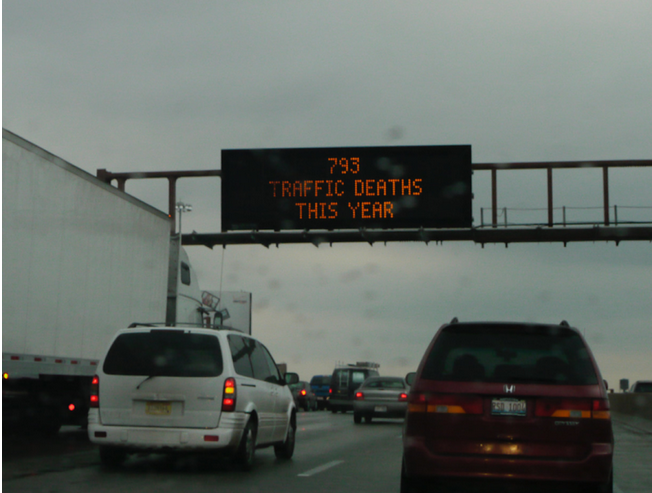Road signs that implore highway motorists to drive carefully by reminding them of roadway death totals may actually be causing crashes because they're too distracting, a new study finds — and its provoking a conversation among advocates about the limits of on-road safety signs more broadly.
A new Science Magazine analysis of a Texas campaign found that driving passed a dynamic billboard that displays the number of people killed that year on Lone Star State roads increased a motorists' chance of being involved a crash soon thereafter by about 4.5 percent, even when controlling for factors like the time of day, day of the week, whether or not it was a holiday, and the weather.
That might not sound like a huge spike, but the researchers say that could translate to an additional 17,000 crashes and 140 roadway fatalities every year across the 28 states that have used the strategy since 2012. That's an impact roughly equivalent to increasing highway speed limits by three to five miles per hour — and as the death toll grows more alarming over the course of the year, crashes among distracted motorists do, too.
"We were totally surprised," said Joshua Madsen, assistant professor at the Carlson School of Management and the co-author of the study. "We thought these signs would make roads safer. I guess we joked around that it would be funny if they didn't — well, funny in all the wrong ways."
this is such an indictment of the "drive safe" personal responsibility messaging that comprises most Vision Zero campaigns. pic.twitter.com/PHicvNAmXk
— Megan Kimble (@megankimble) April 28, 2022
Of course, it certainly seems ironic that an anti-distracted-driving campaign itself would cause distracted driving. For street safety advocates, though, Madsen's findings are just the latest entry into a massive body of research into how the built environment encourages drivers to check out behind the wheel — even when the people who designed it say that safety is their top goal.
Much like wide lanes, high speed limits, and even the infotainment systems built into the very dashboards of many cars, researchers have known since at least 2012 that digital advertising billboards are capable of stealing a driver's attention for just long enough to double the chance of a crash; safety-conscious countries like Sweden have even made them illegal.
Madsen thinks the "dynamic message sign" campaigns at the center of his study may be even more distracting, not just because they're placed directly on highway overpasses, but because of the disturbing content of the warnings themselves.
"Fatality disclosures are very sobering, very salient, and uber-distracting," he added. "Telling drivers that 2,000 people have died on the roads that year is fundamentally different than saying it'll take you 20 minutes to get downtown under current traffic conditions. It can get you really preoccupied, and it can really draw your focus away from the task at hand."
Madsen says more research is needed to understand the safety impact of other dynamic safety signage — those zippy one-liners DOTs keep churning out might be a good candidate — but warns that, in general, roadside education campaigns should be backed by more evidence.
"Goodness gracious, its 2022; let's analyze the data," he said. "Let's have DOTs actually conduct some validation and say, 'is this [roadside education campaign] helping, or heaven forbid, is it actually hurting?'... We need to ask ourselves: what is the right mix of messages, the right content for these messages, the right time and way to show them — or maybe even, should we just not be having messages [on roadsides] at all?"
In their paper, Madsen and his co-author call for safety leaders to consider the "trade-offs of using behavioral interventions versus taxes and subsidies to address externalities such as unsafe driving, pollution, and global warming."
Street safety advocates might add that simply designing roads to force drivers to pay attention should be a priority, too — especially on non-highway contexts where non-drivers might be traveling. And if we do that everywhere, someday we may not need a reminder of how many people die on U.S. roads at all — because by then, no one will.






